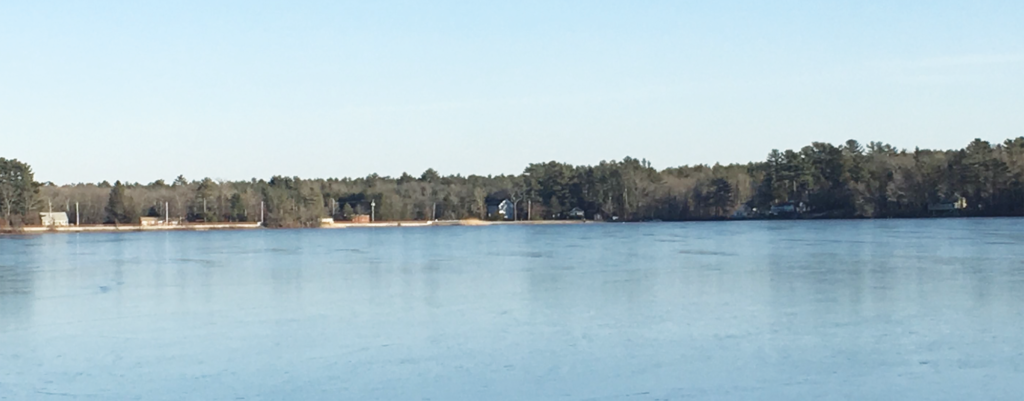
The calm serene ice on East Monponsett Pond looks deceptively slick – ready for a pair of sharpened blades to write their stories on the surface. Don’t do it! (Photo by Deb Anderson)
Despite the recent cold snaps, officials are warning that the conditions of the ice on many bodies of water across the Commonwealth are uncertain, according to the Massachusetts Emergency Management Agency (MEMA). MEMA is warning of an uptick in ice rescues of individuals and pets and is therefore issuing safety precautions to be taken on frozen lakes, rivers, bogs and ponds.
“Before we experience a tragedy that is unfortunately too common this time of year, it is important that we remind everyone, particularly children, of the dangers of unsafe ice,” said MEMA Director Kurt Schwartz. “People may be a bit impatient and venture out on the ice for skating, hockey, ice fishing and other winter sports before understanding the conditions. We highly recommend the use of recreational skating areas provided by the Commonwealth and … local communities. It is very important to exercise precaution and common sense.”
MEMA says you can check with local officials to ensure that safe ice conditions exist. But, due to the uncertainty and constant changing of ice conditions and the dangers presented, they say many officials choose not to endorse the safety of lakes, ponds, streams, bogs or rivers. The strength and thickness of ice should be known before any activity takes place.
Plympton Fire Captain John Sjostedt said, echoing state fire officials, “The only safe ice is at a skating rink. Ice on moving water in rivers, streams and brooks is never safe. The thickness of ice on ponds and lakes depends upon water currents or springs, depth and natural objects. Changes in temperature cause ice to expand and contract, which affects its strength. Because of these factors, ice cannot be called safe.”
Sjostedt added, “Our members are trained to conduct ice rescue if the need arises. The Plympton Firefighters Association recently purchased a new cold weather suit for the department. When we [educate] the public, we fill a five-gallon pail with ice water and put 100 pennies in the bottom of the bucket. We ask the participants to take one penny out of the bucket at a time. This shows them what can happen and how [the] body constricts if they were to fall through the ice.”
The following tips from MEMA could save your life:
• Never go onto the ice alone. A friend may be able to recue you or go for help if you fall through the ice.
• Always keep your pets on a leash. If a pet falls through the ice do not attempt to rescue your pet; call 911 or go for help.
• New ice is usually stronger than old ice. As ice ages, the bond between the crystals decays, making it weaker, even if melting has not occurred.
• Beware of ice covered with snow. Snow can insulate ice and keep it strong but can also insulate it to keep it from freezing. Snow can also hide cracks, weak and open ice.
• Slush is a danger sign, indicating that ice is no longer freezing from the bottom and can be weak or deteriorating.
• Ice formed over flowing water (rivers and lakes containing a large number of springs) is generally 15 percent weaker.
• Ice seldom freezes or thaws at a uniform rate. It can be one foot thick in one spot and be only a few inches thick 10 feet away.
• Reach-Throw-Go. If a companion falls through the ice and you are unable to reach that person from shore, throw them something (a rope, jumper cables, tree branch, etc.). If this does not work, go for help or call 911, before you also become a victim. Get medical assistance for the victim immediately.
• If you fall in, try not to panic. Turn toward the direction from which you came. Place your hands and arms on the unbroken surface, working forward by kicking your feet. Once out, remain lying on the ice (do not stand) and roll away from the hole. Crawl back to your tracks, keeping your weight distributed until you return to solid ice.